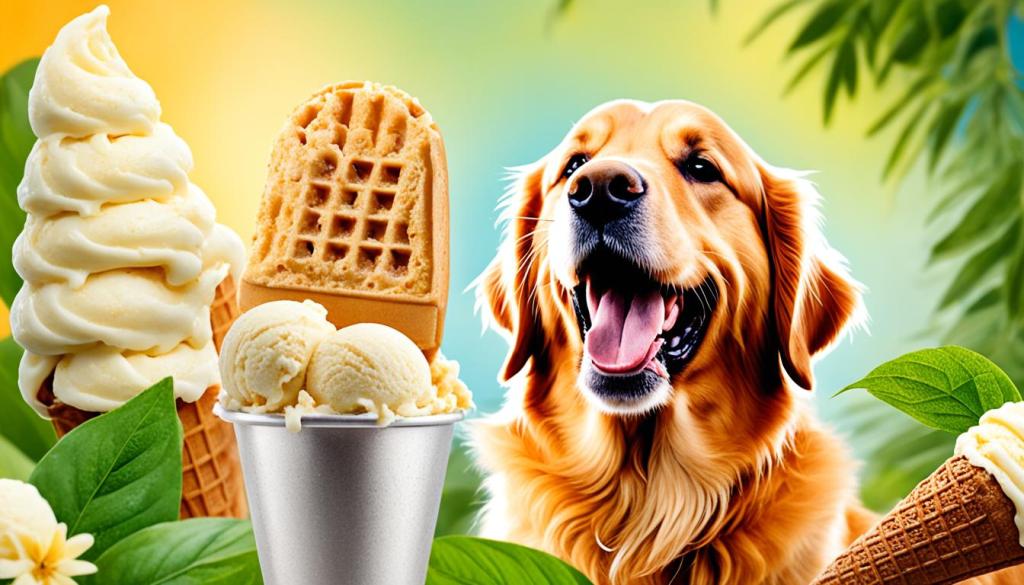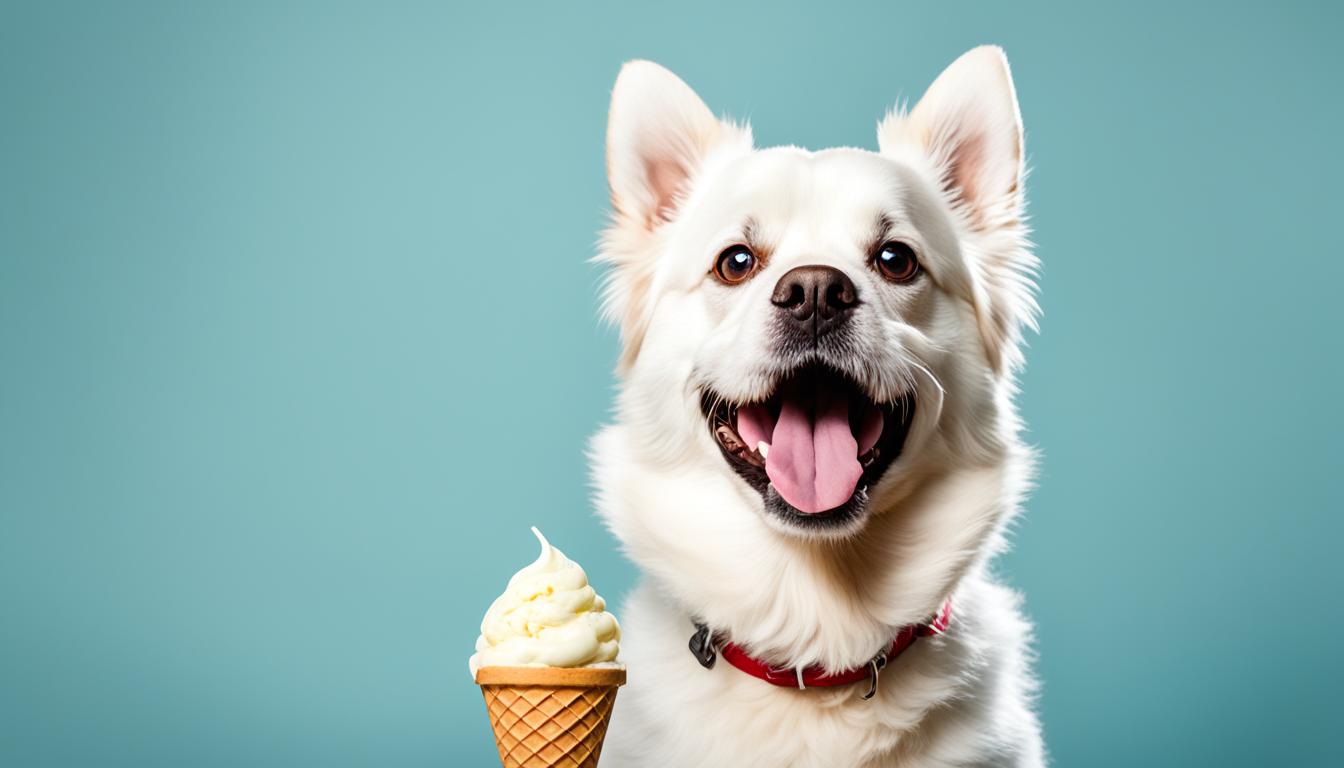As a dedicated pet parent, one might wonder about the variety of safe human foods for dogs. Vanilla is ubiquitous in countless kitchen pantries nationwide and is known for its sweet aroma and rich flavor. So, when it comes to treating our furry friends, the question arises: can dogs have vanilla?
Vanilla for dogs stirs up plenty of intrigue amongst dog owners grappling with the safety and benefits of sharing this classic flavor. Is vanilla safe for dogs? Does it hold potential health benefits, or could it harbor risks? This article will delve into these pressing questions, offering clarity to those who wish to explore the options of feeding dogs vanilla.
It is crucial to understand the components of this aromatic treat, its appropriate forms, and how it fits into a canine’s diet. The goal remains simple: prioritizing our pet’s health and happiness while indulging them safely.
Key Takeaways
- Explore the safety of feeding dogs vanilla and what forms are acceptable.
- Understand the importance of moderation in introducing vanilla into a dog’s diet.
- Learn about the potential risks and health considerations when offering this flavor to canines.
- Gain knowledge on the necessary steps to ensure responsible pet ownership with human food treats.
- Discover expert tips for safely incorporating vanilla as a treat for dogs.
Understanding Vanilla and Its Ingredients
The vanilla orchid has captivated the senses with its delicate fragrance and profound flavor, earning its spotlight both in the culinary world and increasingly as a treat for dogs. When exploring the benefits of vanilla for dogs, it’s crucial to grasp the essence of where vanilla comes from and what it is made of. Vanilla’s journey starts as a climbing orchid native to Mexico.
When contemplating vanilla as a treat for dogs, it’s important to distinguish between the types of vanilla available: the pure extract, the flavoring, and the entirety of the bean. Pure vanilla extract is derived through an alcohol extraction, which pulls the flavor from the cured beans. Conversely, flavorings may contain synthetic vanillin or a mixture of natural vanilla extract and other ingredients. The variations in extraction and composition affect not only the quality but also the suitability of vanilla as a treat for dogs.
Natural vanilla extract typically contains minimal ingredients: vanilla bean, alcohol, and water. This simple, pure form is considered when discussing the benefits of vanilla for dogs. However, synthetic versions known as artificial vanilla or “vanillin” can contain additives that might not be dog-friendly.
- Natural vanilla beans provide a less concentrated flavor but are a whole food product.
- Vanilla extract, being the most potent form, should be used sparingly if included in dog treats.
- Vanilla flavoring is often the least preferred due to potential artificial additives.

In summary, vanilla’s compatibility as a canine treat relies on understanding its natural origins, the extraction process, and the form it uses. With a clear picture of vanilla’s essence, dog owners can make informed decisions about its use, tapping into possible benefits of vanilla for dogs while simultaneously ensuring their furry friend’s safety.
Can Dogs Have Vanilla?
Delving into the sweet world of vanilla and its compatibility with our canine companions raises essential considerations. Many dog owners ask, “Can puppies eat vanilla?” and “Is vanilla safe for dogs?” Understanding which types of vanilla are pet-friendly is essential before incorporating this flavor into your dog’s treats.
Identifying Forms of Vanilla Safe for Dogs
Feeding dogs vanilla should be approached cautiously, as not all forms are equal. The type of vanilla considered generally safe is the natural vanilla extract, and even then, it should be used sparingly in dog treats. Artificial vanilla flavorings or products containing xylitol must be avoided, as they can harm dogs.

Guidelines for Feeding Dogs Vanilla
When it comes to feeding dogs vanilla, moderation is key. Here are recommended practices for dog owners:
- Use only pure vanilla extract and avoid synthetic vanillin or vanilla flavoring.
- Limited quantities are essential – aim for a few drops in baked dog treats.
- Always consider the size and weight of your dog – smaller breeds should have minimal amounts.
- Introduce vanilla gradually to monitor for any adverse reactions.
Remember that puppies have sensitive digestive systems, so “Can puppies eat vanilla?” should be answered with even more care, opting for minute quantities, if any.
Signs to Watch Out for When Dogs Consume Vanilla
After introducing vanilla to your dog’s diet, observation is crucial. Look out for the following signs, which could indicate an adverse reaction:
| Sign | Description | Action |
|---|---|---|
| Vomiting | Expulsion of stomach contents | Contact veterinarian |
| Diarrhea | Loose or watery stools | Provide hydration, seek advice |
| Lethargy | Decreased energy or interest | Monitor closely, call the vet |
| Hyperactivity | Increased energy or agitation | Reduce stimulants, consult vet |
If any of these symptoms present after feeding your dog vanilla, you must cease giving the treat and seek veterinary advice.
Potential Benefits and Risks
When considering adding vanilla to your dog’s diet, it’s essential to weigh the benefits against the risks. Vanilla-flavored dog treats can be a delightful way to reward your pet, but understanding the implications of such treats is vital for their health. Below, we’ll explore the dual aspects of feeding your dog this popular flavor.
Benefits of Vanilla for Dogs
Vanilla has been noted for its pleasant aroma and flavor, making vanilla-flavored dog treats quite appealing to your canine friends. Some pet owners believe that vanilla can have a calming effect on dogs, potentially helping them relax and relieve anxiety. Vanilla’s enticing scent can also benefit older dogs with diminishing appetites or picky eaters. Here’s a glimpse at the positive effects this flavor might bring:
- Enhanced dog treats taste, making them more enjoyable for your pet.
- Possible anti-anxiety benefits attributed to the natural compounds in vanilla.
- Increase palatability for dogs who may be opposed to their regular diet.
Risks of Feeding Dogs Vanilla
Despite its potential benefits, there are risks of feeding dogs vanilla that cannot be ignored. The concentration of vanilla in various forms, like extracts, can contain alcohol, which is harmful to dogs. Artificial vanilla flavorings may also have additives that can be toxic to your pet. It’s crucial to consider these concerns:
- Alcohol content in vanilla extract can pose a risk of toxicity to canines.
- Possibility of allergic reactions or intolerance to vanilla or its components.
- Artificial sweeteners such as xylitol, often found in sugar-free vanilla products, can be lethal to dogs.
How to Mitigate Potential Risks
While vanilla benefits exist for dogs, responsible pet ownership involves minimizing the associated hazards. Here’s a strategy for safely integrating this flavor into your dog’s treats:
- Consult with a veterinarian before introducing vanilla-flavored treats to your dog’s diet.
- Opt for dog-specific treats that contain natural vanilla in safe, minimal quantities.
- Always check the ingredients list for harmful substances like xylitol or excessive sweeteners.
Mindfulness about the quality and quantity of vanilla in your dog’s treats can help ensure they enjoy the flavor safely. Regular check-ups and dietary discussions with your vet are always recommended to maintain your dog’s optimal health.

Conclusion
In navigating the sweet realm of canine treats, the question “Can dogs have vanilla?” warrants mindful consideration. Vanilla can be a zestful addition to dogs’ diets when appropriately managed. As we have explored the multitude of facets involving vanilla’s safety for dogs, a central theme prevails: moderation and discerning oversight are fundamental. By reflecting on the informative journey through the benefits and potential risks associated with feeding dogs vanilla, pet owners are better equipped to make sound decisions tailored to their furry companions’ well-being.
Safety considerations should not be underestimated when introducing any new element to a dog’s diet. Is vanilla safe for dogs? It can be offered in prudent amounts and derived from quality sources. We’ve underscored the significance of distinguishing between natural and synthetic vanilla, emphasizing pet parents’ need to scrutinize the origin and composition of vanilla-flavored treats.
The overarching message from this article resonates with the creed of responsible pet ownership. Ensuring the health and happiness of our dogs means leaning on credible information and, when in doubt, seeking the wisdom of a qualified veterinarian. With the key points of guidance provided herein, may pet owners feel empowered—balancing the joys of treating their canine friends with the imperative to uphold their health and safety.
FAQ
Can dogs have vanilla?
Dogs can have vanilla in small amounts, but it must be natural vanilla extract, not artificial, and it should be given in moderation. It’s essential to ensure that the vanilla contains no additional harmful ingredients, such as xylitol, which is toxic to dogs.
What is vanilla, and where does it come from?
Vanilla is a flavor derived from the orchids of the genus Vanilla. The primary component of vanilla is vanillin, which can be extracted from the vanilla bean pods that the orchids produce. It originated from Mesoamerica and is now grown in various tropical regions.
What are the safe forms of vanilla for dogs?
The safest form of vanilla for dogs is a small amount of pure vanilla extract used in making dog-safe treats. Whole vanilla beans and high concentrations of vanilla extract should be avoided to prevent potential toxicity or gastrointestinal upset.
What should I do if my dog reacts poorly after consuming vanilla?
If your dog shows signs of an allergic reaction or toxicity, such as vomiting, diarrhea, or lethargy, seeking immediate veterinary attention is crucial. Keep a sample of your dog’s consumption to help the veterinarian determine the best action.
Are vanilla-flavored dog treats safe for my dog?
Vanilla-flavored dog treats from reputable brands are generally safe for dogs. They’re formulated to be non-toxic and are in quantities considered safe for canine consumption. Always check the label for any potentially harmful ingredients.
How can I mitigate the risks when feeding my dog vanilla?
To mitigate risks, always choose pure vanilla extract without any additional harmful ingredients and only use it in minimal amounts in homemade or commercially prepared dog treats. Consult with your veterinarian before adding vanilla to your dog’s diet, especially if they have underlying health conditions.
Also read a separate guide if you want to offer Egg Shells , Pistachios , Pepperoni , Bok Choy and potatoes to your dogs.

